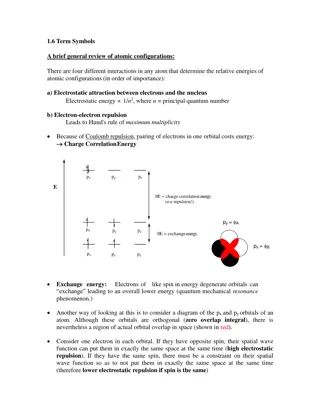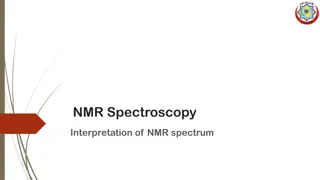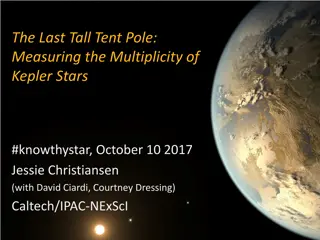Using the SPIN Funding Opportunities Database
Navigate the SPIN Funding Opportunities Database effectively with guidance from Karen Markin, Ph.D. Learn how to search by keywords, view results, and access program descriptions. Boost your grant-seeking success!
0 views • 15 slides
Insights on Fragment Spin Generation in Fission: What We Know
Considerable insight was generated from a recent conference on fission, shedding light on crucial theoretical and experimental aspects. Key topics include angular momentum, fission-fragment spin references, and the dynamics of nuclear fission. Theoretical advancements like the TDSLDA model and super
3 views • 41 slides
Research Program on Spin Polarized Nuclei in Fusion Plasmas
Examination of spin polarized fuel in fusion plasmas to enhance energy production efficiency. Planned experiments aim to measure the lifetime of polarized nuclei for optimized fusion reactions. Key aspects include depolarization mechanisms, neutral beam heating, and fueling techniques with pellets.
1 views • 36 slides
Understanding AGN Jet Production Efficiency: Insights from Spin and Magnetic Flux
A fundamental question in astrophysics is how efficiently active galactic nuclei (AGN) produce jets. Black hole spin and magnetic flux play crucial roles in determining the jet production efficiency. High-spin values and large magnetic flux threading are essential for generating high-efficiency jets
2 views • 22 slides
Crystal Field Theory in Transition Metal Complexes
Crystal Field Theory (CFT) explains the colors and magnetic properties of transition metal complexes. It focuses on the energy changes in d-orbitals of metal ions caused by surrounding ligands. This theory, developed in 1929, provides insights into the bonding interactions in complex compounds. The
10 views • 44 slides
Understanding Atomic Configurations and Term Symbols
The energy of atomic configurations is determined by electrostatic attraction between electrons and the nucleus, electron-electron repulsion, spin-orbit coupling, and spin-spin interactions. Term symbols in electronic spectroscopy specify atomic states using quantum numbers. Hund's rule and the Paul
8 views • 12 slides
Pascal's Rule in NMR Spectroscopy ( n+1 )
Pascal's Rule in NMR spectroscopy, also known as the (N+1) rule, is an empirical rule used to predict the multiplicity and splitting pattern of peaks in 1H and 13C NMR spectra. It states that if a nucleus is coupled to N number of equivalent nuclei, the multiplicity of the peak is N+1. The rule help
1 views • 30 slides
Understanding Crystal Field Theory in Chemistry
Crystal Field Theory (CFT) explains how electron orbital degeneracies, particularly d or f orbitals, are affected by a static electric field generated by neighboring anions. In CFT, the metal ion is considered positive while ligands are negative charges, leading to attractive and repulsive forces af
0 views • 13 slides
Theoretical Derivation and Application of Nuclear Shell Model in Quantum Physics
The nuclear shell model, a fundamental concept in quantum physics, is explained in detail using Schrodinger wave equations and spherical coordinates. The model describes the behavior of nucleons in atomic nuclei based on energy values, quantum numbers, and shell closure principles. Spin-orbit intera
0 views • 14 slides
Understanding Angular Momentum in Quantum Mechanics
Exploring the concept of total angular momentum in quantum mechanics, which involves the quantization of orbital and spin angular momenta. The coupling of these vectors leads to the formation of total angular momentum, with implications for the behavior of single-electron systems like the hydrogen a
0 views • 16 slides
Understanding Zero Field Splitting in ESR Spectroscopy
Zero field splitting in ESR spectroscopy involves the relaxation times in ESR and how spin-lattice relaxation affects the spectral width. Discover how T1 value and spin lattice relaxation play a crucial role in observing sharp spectrum lines in EPR. Learn about line widths in ESR, spin dilution, and
0 views • 21 slides
spin class workout
Are you looking for an effective way to shed those extra pounds and boost your fitness level? Look no further than Spin Class Workout! At Cycle Bar, we are passionate about helping you achieve your weight loss goals through the power of Indoor Cyclin
1 views • 2 slides
Understanding NMR Spectroscopy and Chemical Shifts
Nuclear Magnetic Resonance (NMR) spectroscopy is a powerful technique for analyzing molecular structures based on the chemical shifts of protons. In an NMR spectrum, peaks correspond to different protons in a compound, with their positions, intensities, and spin-spin splitting providing valuable inf
0 views • 19 slides
The Benefits of a Daily 30
Spin workouts, also known as indoor cycling, are an excellent cardiovascular exercise. They help improve heart health, build muscle endurance, and burn calories. One of the most appealing aspects of spin workouts is their versatility.
2 views • 3 slides
Multiplicity Adjustment in Clinical Trials: Methods and Applications
Explore the importance of multiplicity adjustment methods in the design and analysis of clinical trials, including the motivation behind classical approaches, examples of multiplicity problems, and the concept of controlling Familywise Error Rate (FWER). Understand the need for adjusting p-values to
1 views • 25 slides
Unveiling the Impact of Stellar Multiplicity on Exoplanet Detection
Exploring the effects of stellar multiplicity on exoplanet detection, this research highlights the challenges in accurately measuring Earth-sized planets and proposes high-resolution imaging as a solution. By conducting a survey of Kepler non-host stars, significant insights have been gained, sugges
0 views • 9 slides
Unpacking Translanguaging as a Rhizomatic Multiplicity
Explore the rhizomatic nature of Translanguaging, its criticisms, and the concept of multiplicity within linguistic repertoires. Understand how rhizomes function in sociolinguistic research and their implications for language issues and cognition. Delve into the complexities of translanguaging and i
0 views • 15 slides
Estimation of Dead-Time Loss for Neutron Count-Rates
This study discusses the estimation of dead-time loss for high neutron count-rates and the associated multiplicity correction using multi-channel list-mode data. The numerical method for high count-rate dead-time correction in neutron multiplicity counting is described, focusing on the use of multi-
0 views • 6 slides
Open Heavy-Flavour Production in pp Collisions at the LHC - Physics Seminar Overview
Physics seminar presentation by Francesco Prino on open heavy-flavour production as a function of multiplicity in pp collisions at the Large Hadron Collider (LHC). The talk covers the motivation behind studying heavy-flavour production mechanisms, data analysis techniques, results on the multiplicit
0 views • 65 slides
Insights into Parton Branching Equation at LHC Energies
Multiplicity distributions play a crucial role in understanding the cascade of quarks and gluons at the LHC energies, revealing underlying correlations in particle production. Popular models like Monte Carlo and statistical models are used to describe the charged particle multiplicity distributions.
1 views • 17 slides
Neutron Multiplicity Measurement in Muon Capture on Oxygen in Super-Kamiokande
Explore the neutron multiplicity measurement in muon capture on oxygen using Super-Kamiokande, a water-Cherenkov detector located underground in Japan. Gadolinium was added to enhance neutron tagging efficiency, aiding in Supernova observation, proton decay rejection, and more. Neutron signals are t
0 views • 16 slides
Exploring Jablonski Diagram and Smart Teaching Tools at Christian Eminent College
Delve into the world of Jablonski Diagram through a comprehensive e-content prepared by Prof. Minakshi Panwar at Christian Eminent College, Indore. Understand energy states, spin, and spin multiplicity in molecules. Discover the concepts of absorbance, non-radiative transitions, and the conversion o
0 views • 11 slides
A-29 Emergency Procedure - Erect Spins Revision 19
Recognize an erect spin as an oscillatory movement about the three aircraft axes with high and low speed AOA. Follow the Corrective Action Procedures (C.A.P.) of throttle idle, full opposite rudder direction, and stick neutral. When the spins stop, maintain rudder neutral, adjust throttle and stick
0 views • 4 slides
30 minute spin workout
Stress management is essential for overall health. Regular physical activity, especially high-intensity workouts like spin classes, is known to reduce stress levels. A 30 Minute Spin Workout provides a concentrated burst of exercise that stimulates t
3 views • 6 slides
Understanding Quark Sivers Function and Spin-Dependent Odderon
Quark Sivers function, a key aspect in quantum chromodynamics, plays a role in capturing orbital angular momentum and spin-orbit coupling. Spin-dependent Odderon, an elusive three-gluon exchange, contributes to cross sections in high-energy collisions. Small-$? TMDs from polarized Wilson lines provi
0 views • 17 slides
Understanding Electron Paramagnetic Resonance (EPR) and Molecular Symmetry
The discussion covers the relevance and applications of EPR spectroscopy in studying electron behavior, spin-orbit coupling effects, and molecular symmetry. Key concepts include anisotropy, nuclear spin coupling, and deviations in electron g-factors. It delves into how these factors impact the obser
0 views • 11 slides
Impact of Drag and Spin on Baseball Flight
Understanding how drag and spin influence the flight of a baseball is crucial in explaining phenomena like why fly balls carry better to center field and how sidespin affects distance. Sidespin reduces distance by increasing drag, which competes with lift generated by backspin. The dependence of sid
1 views • 21 slides
Exploring Fidget Spinners: Science Lesson on Spin Time and Averages
Uncover the fascinating world of fidget spinners with a science lesson on spin time measurement techniques, calculating averages, and factors influencing spin time. Dive into hands-on activities, investigations, and discussions on materials used, bearing types, and spinner weights.
0 views • 28 slides
Understanding Nucleon Spin Decomposition and Proton Spin Problem
Explore the complex realm of nucleon spin decomposition and the enigmatic proton spin problem, delving into concepts like orbital angular momentum, quarks and gluons' helicity, and longitudinal double spin asymmetry in polarized deep inelastic scattering. Learn about the spin crisis, gluon polarizat
0 views • 26 slides
Understanding Spin Magnetism in NMR: An Introduction to Angular Momentum and Magnetic Moments
Delve into the world of spin magnetism in NMR as we explore the concepts of angular momentum, magnetic moments, Stern-Gerlach experiments, and the quantization of spin. Learn about spin projections, spin relaxation, and the relationship between spin particles and external magnetic fields.
0 views • 34 slides
Colorful Numbers and Spin! Tekhnologic Image Collection
Featuring various colorful numbers and a spin element, the Tekhnologic image collection includes images of green, yellow, blue, and red elements. The series showcases a playful and vibrant aesthetic, with each number highlighted in a different color. With a total of four sets, the collection offers
0 views • 1 slides
Challenges and Solutions in High-Multiplicity Jet Production Studies
Theory and methodology challenges in the universality and production of W+multijet events are discussed, emphasizing the importance of accurate predictions and scale independence. The NLO revolution and on-shell methods are explored, along with software tools like BLACKHAT and SHERPA. Managing compu
0 views • 14 slides
Investigation of Spin Observables in Elastic pp and p(bar)p Scattering at SPASCHARM Program
Measurements of spin observables in elastic pp and p(bar)p scattering at 16 GeV will be conducted at the SPASCHARM program using a unique setup with polarized proton and antiproton beams. The experiment aims to extend the energy range for spin studies and compare elastic scattering in pp and p(bar)p
0 views • 24 slides
Exploring Higher Spin AdS3 Holography and Superstring Theory
Delve into the fascinating world of higher spin gauge theory, Vasiliev theory, and their applications in AdS/CFT correspondence. Discover the complexity and tractability of higher spin states in superstring theory, as well as the concrete relations between superstrings and higher spin fields in AdS
0 views • 27 slides
Understanding Political Spin and Propaganda in Media
Explore the tactics of political spin and propaganda as tools used to shape public perception and manipulate information. Learn about the techniques politicians employ to navigate media dynamics and the covert spin tactics employed in the realm of communication and journalism.
0 views • 10 slides
Insights into Theoretical Approaches in NMR Spectroscopy
Theoretical approaches in NMR spectroscopy encompass diverse methods, each with varying degrees of approximation but yielding correct results within their validity. Techniques such as transition probabilities using the time-dependent perturbation theory, Zeeman interaction for energy level transitio
0 views • 32 slides
Comparing Polarized Gas Targets at LHC and HERA for Spin Studies
The comparison between Polarized Gas Targets (PGT) at the Large Hadron Collider (LHC) and HERA for spin studies is discussed. Key considerations such as beam-induced depolarization, beam parameters, and design aspects are highlighted. The importance of using a polarized gas target similar to HERMES
0 views • 15 slides
Numerical Method for High Count-Rate Dead-Time Correction in Neutron Multiplicity Counting
Neutron detectors in safeguards utilize multi-channel list-mode recorders for advanced dead-time correction, improving data analysis. The method involves estimating lost pulses and correcting multiplicity histograms to enhance counting accuracy. Through an iterative process, dead-time probabilities
0 views • 6 slides
Relativistic Treatment of Spin Particles: Dirac Equation & Special Relativity
Exploring the Dirac equation for spin particles within the framework of special theory of relativity. Topics covered include energy-momentum relationships, basics of special relativity, Lorentz transformations, and relativistic effects on particles. The lecture delves into the interplay between quan
0 views • 23 slides
Understanding Geometric Frustration in Magnetism and Ice
Explore the concept of geometric frustration in magnetism and ice, where energetic requirements cannot be optimized simultaneously. Learn about frustrated magnetic insulators, quantum spin liquids, and the unique properties of geometrically frustrated systems such as triangular and Kagome lattices.
0 views • 25 slides







































